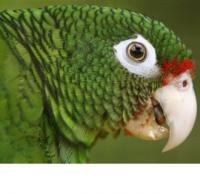Endangered parrot on the rise in PR
Submitted on 26 June 2011 - 7:42pm
This article is reproduced by CienciaPR with permission from the original source.

By : The Associated Press
Caribbean Business
Deep amid the dense greenery of a rain forest, down an unmarked road, behind a barbed wire fence in a low-slung compound monitored by security cameras, government scientists are nursing a special patient back to health.
The patient is on pain medication, but lucid enough to ruffle his emerald green feathers and fill the room with angry squawks when a biologist removes him from an incubator. It is a Puerto Rican parrot with a broken leg, a serious injury for one of the world’s most endangered bird species.
In the past, the prognosis would have been grim. “That probably would have been a dead bird,” said Jafet Vélez, a biologist who manages the Puerto Rican parrot breeding center in the El Yunque National Forest, one of two such facilities on the island.
The injured bird, a 2-month-old known only as Number 111405, faces an extended stay in the avian equivalent of intensive care and may need surgery. But it is likely to survive. The outlook is increasingly positive as well for the entire species, which has hovered near extinction for decades, with slightly more than a dozen left in the wild at one point.
“Everything is moving in a positive direction,” said Tom White, a U.S Fish & Wildlife Service biologist who helps manage the island’s wild parrot populations.
It is difficult to pinpoint the number of birds because they are elusive and not all have functioning radio collars. But White said there are 20-25 in El Yunque, east of San Juan, and 40-70 in Río Abajo Nature Preserve along the Arecibo-Utuado border.
Both groups have done well enough that the FWS and its partner, Puerto Rico’s Department of Natural & Environmental Resources, are looking to create additional wild populations, with the next one possibly in the U.S. territory’s rugged, sparsely populated western Maricao region. The next release of birds from captivity is scheduled for December.
There are now about 150 birds each in the two captive breeding centers, in El Yunque and in Río Abajo. Both breeding centers report a record year for new chicks, about 40 each.
Puerto Rican parrots are one of about 34 species of Amazon parrots found in the Americas. Amazona vittata are known for the bright red shock of feathers at their forehead, white rings around their eyes and the shimmering blue feathers under their wings, usually visible when they dart overhead.
The parrots, which grow to about a foot in length and mate for life, are secretive and considered exceptionally sensitive to any disturbance to their environment, which may be why their numbers plummeted in the wild.
In pre-colonial times, there were an estimated 1 million of the birds spread across Puerto Rico. Intensive agriculture, particularly the massive clearing of forests for sugar cane, coffee and citrus, and a series of devastating hurricanes destroyed most of their prime habitat. By the late 1960s, they had disappeared from the entire island, except a few dozen in El Yunque, a mountainous tropical rain forest east of San Juan. In 1975, a census found just 13 birds left in the wild.
The captive breeding program began in 1972, but there wasn’t much hope for a recovery.
“They thought the species is going to be extinct, so we need to keep in captivity a representation of what was a Puerto Rican parrot,” said Vélez, who has worked for the program for 21 years. “But the species really showed resilience.”
The first chick was produced in captivity in 1979, but the program was slow to get off the ground. Throughout the 1980s and for much of the 1990s, biologists rarely had more than 10 hatch and never had more than that make it out of the nest, or fledge, he said.
But breeding efforts picked up as they learned more about the species and reduced turnover among biologists and technicians, which enabled them to become more skillful in handling the birds, Vélez said. They made adjustments, like making sure to create distance between breeding cages as they realized some birds would not copulate because they were intimidated by the proximity of more aggressive males, a condition known as psychological castration.
They also developed better breeding techniques. Ricardo Valentín, who manages the Río Abajo center, said they started noting significant progress when they started keeping adults and juveniles together in mixed cages in 2000. “Just like with humans, you can’t have a child raise itself,” he said.
The FWS center in El Yunque also benefited from a major upgrade. In 2007, a new captive breeding center and aviary was opened on a three-acre site at a cost of $2 million. The site is remote and under tight security to protect the birds from human disturbances but also possible theft, though there have been few known cases of someone taking a Puerto Rican parrot from the wild to sell on the black market.
With a budget of more than $1.5 million, the center has allowed the team to provide better care for injured birds such as Number 111405, who will only have to go to a sleek operating room in an adjacent room if he needs to have his broken leg repaired with surgery.
The new facility also features a hurricane room to protect the birds in case of storms.
Parrot program officials said they hope to have several wild populations that would be able to intermingle, something the Río Abajo and El Yunque groups do not do now. But they don’t have a specific target number.
“Our basic philosophy is the more the better,” White said.







